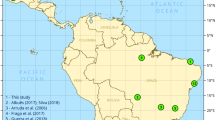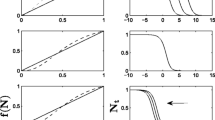Abstract
Mistletoes are common aerial stem-parasites and their seeds are dispersed by fruit-eating birds. In the mutually beneficial relationships between mistletoes and bird species that disperse mistletoes’ seeds, the preference of birds for infected trees influences the spread of mistletoes and the spatiotemporal pattern formation of mistletoes. We formulate a deterministic model to describe the dynamics of mistletoes in an isolated patch containing an arbitrary number of trees. We establish concrete criterions, expressed in terms of the model parameters, for mistletoes establishing in this area. We conduct numerical simulations based on a field study to reinforce and expand our results.
Similar content being viewed by others
References
Aukema, J. E. (2003). Vectors, viscin, and viscaceae: mistletoes as parasites, mutualists, and resources. Front. Ecol. Environ., 1(3), 212–219.
Aukema, J. E., & del Rio, C. M. (2002). Variation in mistletoe seed deposition: effects of intra- and interspecific host characteristics. ECOGRAPHY, 25, 139–144.
del Rio, C. M., Medel, R., Silva, A., & Hourdequin, M. (1996). Seed dispersers as disease vectors: Bird transmission of mistletoe seeds to plant hosts. Ecology, 77, 912–921.
Gerschgorin, S. (1932). Über die Abgrenzung der Eigenwerte Einer matrix. Izv. Akad. Nauk SSSR, Ser. Mat., 7, 749–754.
Hoffmann, A. J., Fuentes, E. R., Cortés, I., Liberona, F., & Costa, V. (1986). Tristerix tetrandus (loranthaceae) and its host plants in the chilean matorral: patterns and mechanisms. Oecologia, 6, 202–206.
Holling, C. S. (1959a). The components of predation as revealed by a study of small mammal predation on the European pine sawfly. Can. Entomol., 91, 293–320.
Holling, C. S. (1959b). Some characteristics of simple types of predation and parasitism. Can. Entomol., 91, 385–398.
Krisztin, T., Walther, H., & Wu, J. (1999). Shape, smoothness and invariant stratification of an attracting set for delayed monotone positive feedback. In Fields institute monographs (Vol. 11). Providence: American Mathematical Society.
Lavorel, S., Smith, M. S., & Reid, N. (1999). Spread of mistletoes (amyema preissii) in fragmented Australian woodlands: a simulation study. Landsc. Ecol., 14, 147–160.
Mallet-Paret, J., & Sell, G. R. (1996). The Poincaré–Bendixson theorem for monotone cyclic feedback systems with delay. J. Differ. Equ., 125(2), 441–489.
Metz, J. A. J., & Diekmann, O. (Eds.) (1983). The dynamics of physiologically structured populations. In Lecture notes in biomathematics (Vol. 68). Berlin: Springer.
Mischaikow, K., Smith, H., & Thieme, H. (1995). Asymptotically autonomous semiflows: chain recurrence and Lyapunov functions. Trans. Am. Math. Soc., 347(5), 1669–1685.
Norton, D. A., & Carpenter, M. A. (1998). Mistletoes as parasites: host specificity and speciation. Trends Ecol. Evol., 13, 101–105.
Reid, N. (1989). Dispersal of mistletoes by honeyeaters and flowerpeckers: components of seed dispersal quality. Ecology, 70, 137–145.
Reid, N., Smith, N. M., & Yan, Z. (1995). Ecology and population biology of mistletoes. In M. D. Lowman, & N. M. Nadkarni (Eds.), Forest canopies (pp. 285–310). New York: Academic Press.
Silva, A., & del Rio, C. M. (1996). Effects of the mistletoe tristerix aphyllus (loranthaceae) on the reproduction of its cactus host echinopsis chilensis. Oikos, 75, 437–442.
Smith, H. L. (1987). Monotone semiflows generated by functional-differential equations. J. Differ. Equ., 66, 420–442.
Smith, H. L. (1993). Reduction of structured population models to threshold-type delay equations and functional-differential equations: a case study. Math. Biosci., 113, 1–23.
Smith, H. L. (1994). A structured population model and a related functional-differential equation: global attractors and uniform persistence. J. Dyn. Differ. Equ., 6, 71–99.
Varga, R. S. (2004). Gerschgorin and his circles. Berlin: Springer.
Author information
Authors and Affiliations
Corresponding author
Rights and permissions
About this article
Cite this article
Liu, R., del Rio, C.M. & Wu, J. Spatiotemporal Variation of Mistletoes: a Dynamic Modeling Approach. Bull Math Biol 73, 1794–1811 (2011). https://doi.org/10.1007/s11538-010-9592-6
Received:
Accepted:
Published:
Issue Date:
DOI: https://doi.org/10.1007/s11538-010-9592-6




